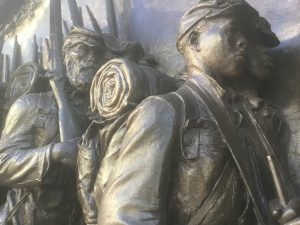
James Gow
Unrest and iconoclasm spread across the United States — and the world — in June 2020. The immediate prompt was video of a white police officer killing a black man in Minneapolis. In a wider sense, however, the eruption of anger is evidently, a manifestation of unreconciliation — it is the continuation of the unreconciled US Civil War. It is a product of the post-Civil War reconciliation between the North and South. That reconciliation between Unionists and Confederates, in the United States, apparently so successful, was, in truth, incomplete and at the expense of those whose profoundly unequal status had been the cause of the war: Americans of African heritage, over four million of whom had been slaves.
Reconciliation and reunion were sealed across the Unionist -Confederate divide. The country was reunited, as fraternal engagement among former enemies and the interests of business and economy, both North and South, urged reconciliation. This movement was also fuelled by Unionists’ weariness of the hard work of enforcing emancipation . Finally, rebellion and recalcitrance in the defeated Confederate states, a factor in the North’s weariness, shaped the reconciliation that occurred. As a result, the past was accommodated and the future became the focus. Five decades after the end of the war in 1865, the sides appeared to be reconciled and to share an understanding that, somehow, both sides had fought nobly in a family feud that had been necessary for national development, but was over and everyone could move on together.
The reconciliation achieved set aside the issues of slavery and black freedom , suggesting a blurred moral equivalence between the Northern and Southern sections. By the time President Woodrow Wilson was speaking at a Peace Jubilee on the fiftieth anniversary of the Battle of Gettysburg, the first southern President in half a century, slavery was forgotten and not mentioned; race was a single, passing mention among other issues dissolved in the reformed nation. By that time, white domination had been largely restored de facto in the South, despite the compound effects of the 13th, 14th and 15th Amendments to the US Constitution, which, along with the Union’s programme of ‘Reconstruction’ to enforce emancipation, proved insufficient to prevent the emergence of ‘Black’ codes and ‘Jim Crow’ laws and practices across the South. These constrained the electoral and civil rights of black citizens, and left them economically shackled, even if the legal bonds of ownership had been removed.
The reconciliation that occurred was possible because it was made between equals — the white soldiers and business people on either side. Black soldiers were increasingly overlooked, forgotten and excluded from reconciliation ‘soldier only’ events, focused on heroism and honour. And just as black soldiers were overlooked, forgotten and excluded, so was the issue at the very core of the war — emancipation. In a sense, this was the reconciliation that was possible. It was also the reconciliation that was necessary to America’s growth as a continental empire. That empire enabled the US to become an economic giant. These were undoubtedly its strengths and made it desirable. It was the ‘right’ reconciliation because it was the one that was achievable in a short time. Yet, it was also the wrong reconciliation, leaving those who had been saved from slavery behind. The key issues of slavery and race at the heart of the civil war were unreconciled.
Reconciliation, then, by-passed the core matters of the war — issue of the status of black citizens that some would perceive as continuing as de facto slavery and of emancipation. It represented suppression of emancipation, the very essence of the struggle, and it came at the expense of the Union’s programme of ensuring compliance in secessionist states as a condition of their rehabilitation in the Union. It was also accompanied by notions of ‘Redemption’ in the South and the emergence of a story telling of victory in defeat, the narrative of the ‘Lost Cause’. These were factors that undermined the reconciliation, making it partial, and, despite the declarations and celebrations that accompanied it, left the country unreconciled.
The compromised and partial reconciliation rendered emancipation unfinished, fermented un-reconciliation and engendered a continuing struggle. That struggle included violence at Charlottesville, Virginia, in August 2017, when three individuals were killed in protests about removing a statue of Robert E. Lee — even though Lee, commander of Confederate forces, was a great figure of the reconciliation. Those killed there were, indeed, the latest victims of the US Civil War, albeit none was killed in a Blue Unionist, or Gray Confederate, uniform. Nor were they killed by anyone wearing those uniforms. But, they were losses in a cold war that continued after the formal end of armed hostilities in 1865, under the umbrella of incomplete, if not derelict, reconciliation — linked to the failure fully to address the status of those who had been the very reason for the war. Collective emotion can take a long time to change — far longer than the intellectual process of acknowledging evidence and changing one’s mind — and far longer than the rational acceptance of physical loss. Hurt can last.
A century after Lee surrendered his forces, effectively ending the Civil War, President Lyndon B. Johnson finally ensured full legal emancipation with voter rights legislation in 1965. The longer-term effects of the 1965 full guarantee of electoral freedoms and voting rights included the election of President Barack Obama, the first black person to hold that office, and also of black office holders in many Southern cities, elected by black majorities. Mayors and legislatures, representing ideas and sentiments among their communities, sought to remove statues that were taken to symbolise the Confederacy and white domination. They rejected those symbols; and debates swirled around Charlottesville, Richmond, Dallas, New Orleans and other cities, where Confederate memorials were being challenged and, in some cases, torn down. These acts of popular democracy were hard to deny — even if considered historical reflection might offer alternative paths and frames. Whichever the path to reconciliation, the undeniable truth was that the US remained unreconciled, over a century and half beyond the end of the Civil War and its limited postbellum reconciliation.
That reconciliation was purchased at the price of the continued subordination and suffering of African Americans. That devil’s deal came to be exposed in the twenty-first century, as a consequence of the full legal protection of emancipation finally cemented in 1965. A true — perhaps third — redemption will recognise the essential historical contributions of the enslaved to the prosperity and success of the American state. The history of African Americans ’ contribution to American success is not marginal, but, rather, underpins the American story. Not only their history, but their self-respect and also that of whites must be redeemed, possibly in some tangible form. America can redeem itself — its history and its future — by including all American history and all the American people. The reconciliation of all persons will require the integration of African Americans into commercial and cultural life. For they are as yet unreconciled.
This article is based on research for ‘James Gow and Rana Ibrahem, ‘The Unreconciled US Civil War’ in Rachel Kerr, Henry Redwood and James Gow eds. Reconciliation After War: Historical Perspectives on Transitional Justice New York: Routledge, 2021.
James Gow is Professor of International Peace and Security, Co-Director of the War Crimes Research Group at King’s College London, and Non-Resident Fellow at the Liechtenstein Institute at Princeton University.
